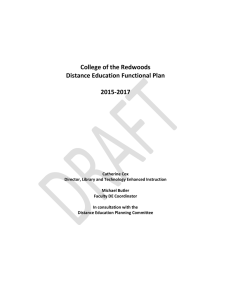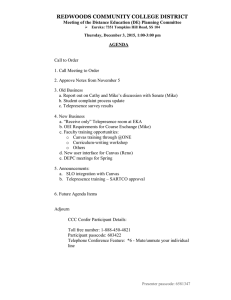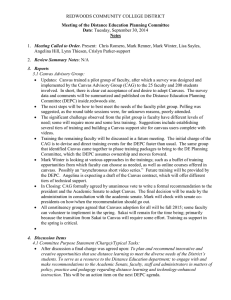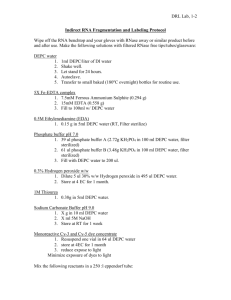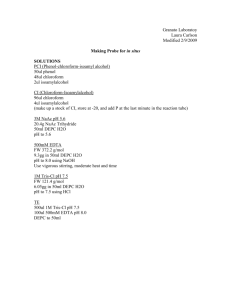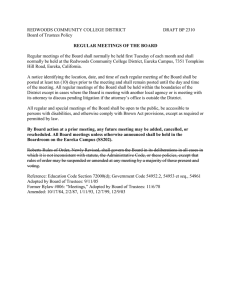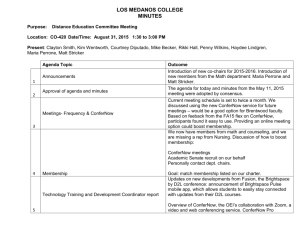College of the Redwoods Distance Education Functional Plan 2015-2017
advertisement
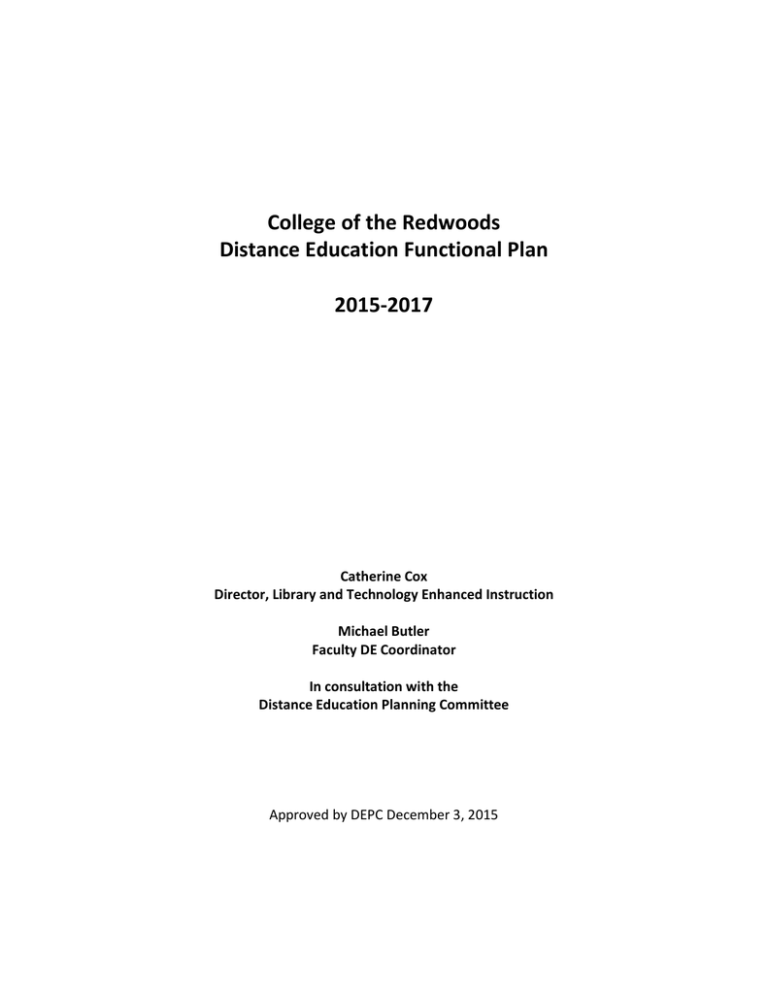
College of the Redwoods Distance Education Functional Plan 2015-2017 Catherine Cox Director, Library and Technology Enhanced Instruction Michael Butler Faculty DE Coordinator In consultation with the Distance Education Planning Committee Approved by DEPC December 3, 2015 P age |2 CR Vision College of the Redwoods is a learning community where lives are transformed. CR Mission College of the Redwoods puts student success first by providing outstanding developmental, career technical, and transfer education. The College partners with the community to contribute to the economic vitality and lifelong learning needs of its service area. We continually assess student learning and institutional performance and practices to improve upon the programs and services we offer. Distance Education Mission Distance Education provides “any time, anywhere” delivery of technology-mediated instruction to enhance student success by improving access to the college’s educational programs. The program also supports faculty in the development and implementation of instructional materials that meet the College’s standards of academic excellence. DEPC approved 12/3/15 P age |3 Overview College of the Redwoods is the sole community college serving Humboldt and Del Norte Counties, and also serves parts of western Trinity County. The main campus is located in Eureka, with two educational centers. The Del Norte center is 94 miles north in Crescent City and the Klamath-Trinity Center is 68 miles to the east in Hoopa. The District is predominately rural and mountainous, with a population of less than 200,000 people distributed across over 5,000 square miles. In 2012, Humboldt County had 134,827 residents while the population of Del Norte County was 28,290, and in both counties 30% or more of the population lives in rural areas. (http://www.city-data.com) Due to the mountainous terrain and the low population density of the District, many residents of the District face lengthy travel times to reach instructional sites. Distance Education (DE) courses offer a valuable opportunity to extend educational access more broadly throughout the District. However, the same factors that make DE important also make provision of DE more difficult, and will require careful planning to ensure that DE is implemented in the most effective and efficient way possible to support the mission of the DE program and the College as a whole. Current DE Resources and DE Infrastructure Learning Management System (LMS) In early 2015, College of the Redwoods began implementation of the Canvas LMS to replace the former LMS, Sakai. The migration from Sakai to Canvas was completed by the beginning of Fall 2015. This positioned CR in the forefront of community colleges throughout the state when the Chancellor’s Office Online Education Initiative (OEI) announced that it had contracted with Canvas for implementation in colleges throughout California. Faculty and student response to Canvas has been extremely positive, especially compared to the previous system, and most faculty have begun to use Canvas to augment their face-to-face courses as well as for DE instruction. In Fall 2015, 72% of instructors college-wide had at least one active course section in Canvas. TelePresence™ The College recently invested a sizeable amount of time and resources in the purchase and implementation of Cisco™ technology to provide interactive two-way streaming audio and video instruction between the main campus in Eureka and the Del Norte and Klamath-Trinity educational centers. At present, the Eureka campus has one room (LRC-105) that is capable of both originating and receiving transmissions. Del Norte has a similar room that can both originate and receive transmissions, as well as a separate, smaller room which can receive only; Klamath-Trinity is only capable of receiving transmissions. The TelePresence™ system also incorporates SpeakerTrak™ technology to allow the system cameras to track the movement of the instructor, providing a better teaching experience. Faculty can also transmit their computer display, information from the classroom whiteboard, and other material to students in other locations. The system is capable of integration with the WebEx™ conferencing system, although as of Fall 2015 the capabilities of that integration are not fully implemented. DE Staff The DE program has several dedicated positions to provide support and oversight to the program: • Director, Technology Enhanced Instruction (.5 FTE) DEPC approved 12/3/15 P age |4 • • Instructional Technologist (1.0 FTE) Faculty DE Coordinator (.4 FTE reassignment) In addition, a newly created ISS-1 position (.5 FTE) has been approved and will be hired in early 2016 to assist faculty and students with support in the development and use of DE materials. DE Policies and Processes CR has created a number of policies and processes to support the development and delivery of a highquality, academically sound Distance Education program. These include a DE Faculty Handbook, websites with resources for both DE Faculty and students enrolled in online courses, and administrative procedures which clearly spell out the basic requirements to ensure DE compliance with Federal, State, and accreditation mandates. In addition, the Distance Education Planning Committee (DEPC) serves as the central planning and oversight committee for DE policies and processes. DEPC is co-chaired by the Director and the Faculty DE Coordinator, and has members representing faculty, IT, Student Services, and student government. DEPC recommendations are carried forward to the appropriate governance, administrative, and other bodies for discussion and approval as needed. At the recommendation of DEPC, the Academic Senate and CRFO approved a memorandum of understanding in 2014 that requires faculty teaching online courses to be certified. One of the recognized methods of certification is the DEPC-developed Online Teaching and Learning Training course (OTLT), which is taught online using Canvas. Planning For Growth In 2013-14, 137 total course sections were offered via Distance Education online. This number dropped by approximately 6% in 2014-15, possibly due to faculty dissatisfaction with the Sakai learning management system and to the lack of institutional support for online courses. Conversion to the Canvas LMS was completed in Fall 2015 and already appears to be having a positive impact on the college. The number of sections offered online in Summer 2015 increased by 18% from 27 to 32 sections, and the increase from Fall 2014 to Fall 2015 was 20%. In Fall 2015, the college offered three courses via TelePresence™. This included one course with concurrent sections offered at Del Norte and the main campus in Eureka, which originated alternately from each site, and two other courses originating from Eureka with concurrent sections at both Del Norte and Klamath-Trinity. Students in all sections of the three courses were surveyed about the new technology in late Fall. Questions asked about their ability to see course presentations, hear the instructor, participate in the class, and whether they could get the instructor’s attention to ask questions. Responses showed that the students at the Eureka campus were the least satisfied with the technology (average response to the four questions was 2.8 out of 5), while those at Klamath-Trinity were the most satisfied (average 4.3 out of 5). Del Norte students averaged 3.15. The primary complaint from students at all three sites was the quality of the audio, and particularly the audio in transmissions originating from the Del Norte site. Plans are being made to address that issue with the installation of sound baffles in the classroom, which should improve the student experience with the technology. DEPC approved 12/3/15 P age |5 Distance Education Functional Plan for 2015 – 2017 In 2012, a draft Distance Education Master Plan was developed which listed four specific goals: 1. Support student success in online programs 2. Develop programs and services to meet community needs 3. Practice continuous quality improvement for online programs 4. Prepare college community to effectively utilize eLearning tools Those four goals were further broken out into specific objectives and actions. While the plan was never approved, many of the objectives remain relevant now, and relate closely to topics currently being discussed and addressed by the Distance Education Planning Committee. This current plan has modified the goals to reflect the current needs and goals of the Distance Education program. In Fall 2015, the Distance Ed Planning Committee (DEPC) approved Outcomes for Distance Education to allow assessment of the overall DE program: 1. The DE program provides students with remote access to courses and degree/certificate programs that support their diverse and changing needs. 2. Distance Education courses are scheduled in a manner that allows students to complete certificate and degree programs within a period of time consistent with established expectations of higher education, in support of equity in success for all students. 3. Students in Distance Education courses achieve course learning outcomes at the same level as students in the same course offered via classroom delivery. Assessment measures for these outcomes include: • The number of approved DE courses • The number of scheduled DE sections • The fill rate of scheduled sections • Analysis of the scheduling patterns of DE courses to determine whether students are able to reasonably complete required sequences of courses in a reasonable length of time • The ability of students to complete a degree program entirely online • Comparison of the success rate of online students vs. students in the same classes offered in a face-to-face mode. DEPC approved 12/3/15 P age |6 GOAL 1: Support student success in online programs Objectives Actions 1.1. Provide students with effective preparation for online learning A. Implement use of OEI student orientation modules. B. Develop a handout of skills needed for success in online courses, for use in advising/counseling. C. DE Director will take ownership of EDUC 203 scheduling/teaching. A. Expand and update OTLT course modules to demonstrate “best practices” in online teaching. B. Support faculty participation in @ONE training for online teaching and Peer Review process for OEI. A. Develop and publicize coordinated 2-year schedule of DE course offerings. 1.2, 1.3 1.4, 1.6 1.2 1.1; 1.2; 1.4 1.2 1.5 4.3, 4.4 1.6 1.5; 4.3 1.6 1.1 1.3 A. Explore options for online tutoring through the OEI. B. Work with Enrollment Services to support online admissions and registration process for DE students. 1.2 -- 1.2 3.6; 4.1; 4.4 1.2 Enhance professional development programs to improve educational effectiveness of faculty 1.3 Schedule DE courses in a way that allows completion of degree and certificate requirements efficiently. 1.4 Improve student access to online student development services DEPC approved 12/3/15 Education Master Plan Strategic Plan P age |7 GOAL 2: Improve access to CR courses and programs Objectives 2.1 Develop at least one degree that is available fully online. 2.2 Identify and meet community needs for access to courses and programs 2.3 Prepare CR for participation in the OEI Online Course Exchange 2.4 Increase DE offerings and enrollment. DEPC approved 12/3/15 Actions A. Work with divisions to identify and develop curriculum to meet all GE areas. B. Work with Deans and Directors of academic programs to identify key courses needed for online program completion. A. Form a Distance Education Community Advisory Group with wide-ranging membership including representatives of K12, Workforce, Tribal Councils, and other interested parties. B. Work with representatives of interested Tribal Councils to establish TelePresence™ course delivery to specified locations. C. Implement full WebEx™ capabilities for remote access to TelePresence™ courses. A. Support faculty in becoming Peer Online Course Reviewers for the OEI. B. Support faculty in obtaining training in online pedagogy through @ONE or other OEIapproved methods for teaching in the Online Course Exchange C. Identify specific courses for development and submission to the course exchange. D. Develop mechanisms for supporting faculty in the development of courses for submission to the OEI course exchange A. Expand capacity of TelePresence™ system by creating a “receive-only” room at Eureka campus. B. Develop and offer a DE curriculum development workshop for faculty C. Market DE program to external community Districtwide. Education Master Plan Strategic Plan 1.1, 1.4, 4.4 1.3, 1.6 1.1, 1.4, 4.3, 4.4 1.3, 1.6 1.6, 4.3 2.1, 2.2, 3.4, 4.5, 5.5 1.4, 1.6, 4.3 1.3, 5.1 4.1, 4.3, 4.4 4.1 4.3 1.2, 1.6 4.3 1.6 1.4 1.3, 3.2 4.3 -- 4.1, 4.3 4.1, 4.2, 4.4 4.3, 4.4 1.6 -- 5.5 P age |8 GOAL 3: Practice continuous quality improvement for online programs Objectives Actions 3.1 Conduct ongoing, systematic assessment of DE outcomes which is used for program improvement. A. Develop outcomes for DE that are measurable and appropriate, and assess outcomes on a regular schedule. B. Conduct an annual review of the indicators used to assess DE outcomes as part of the DEPC planning process each year. C. Analyze course success rates for students in online sections with those of students in faceto-face sections. A. Provide Canvas training workshops for faculty using the LMS online or in face-to-face course delivery. B. Hire additional DE staff to assist faculty with technical aspects of DE course development. C. Develop SARTCO or other method of providing compensation for online course development. A. Track state authorizations for Distance Education and develop process for monitoring compliance. B. Revise process for online handling of student complaints. A. Pilot and implement a webbased system to conduct student surveys for faculty evaluation. B. Recommend that evaluation teams for faculty teaching online contain at least one person who has completed OTLT (or equiv.) A. Meet each semester with Tech Planning Committee AND Facilities Planning Committee on status of DE and planning for the future. 3.2 Provide appropriate support for faculty development and teaching of DE courses. 3.3 Ensure compliance with state and federal regulations for distance education. 3.5 Provide method for evaluation of faculty teaching online sections comparable to faculty teaching face-to-face sections. 3.6 Improve coordination between DE and those departments responsible for IT infrastructure DEPC approved 12/3/15 Education Master Plan Strategic Plan 3.3 3.5 3.1, 3.3 4.5 3.2, 3.3 1.2, 3.5, 4.5 4.3, 4.4 1.6 4.3, 4.4 1.6 4.3, 4.4 1.6 -- 4.5 -- 5.1 4.3 4.4, 4.5 1.5; 4.3 3.6 4.1, 4.3 4.1, 4.5
